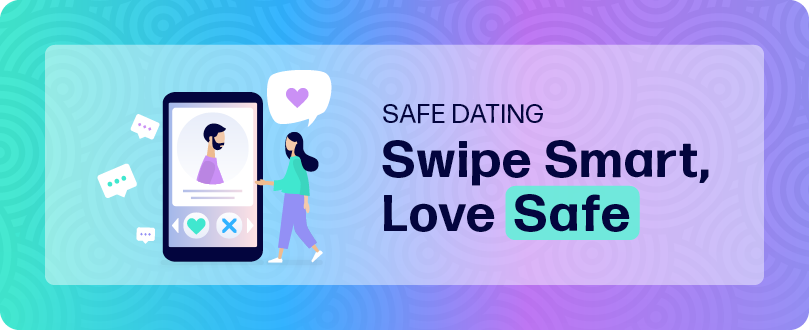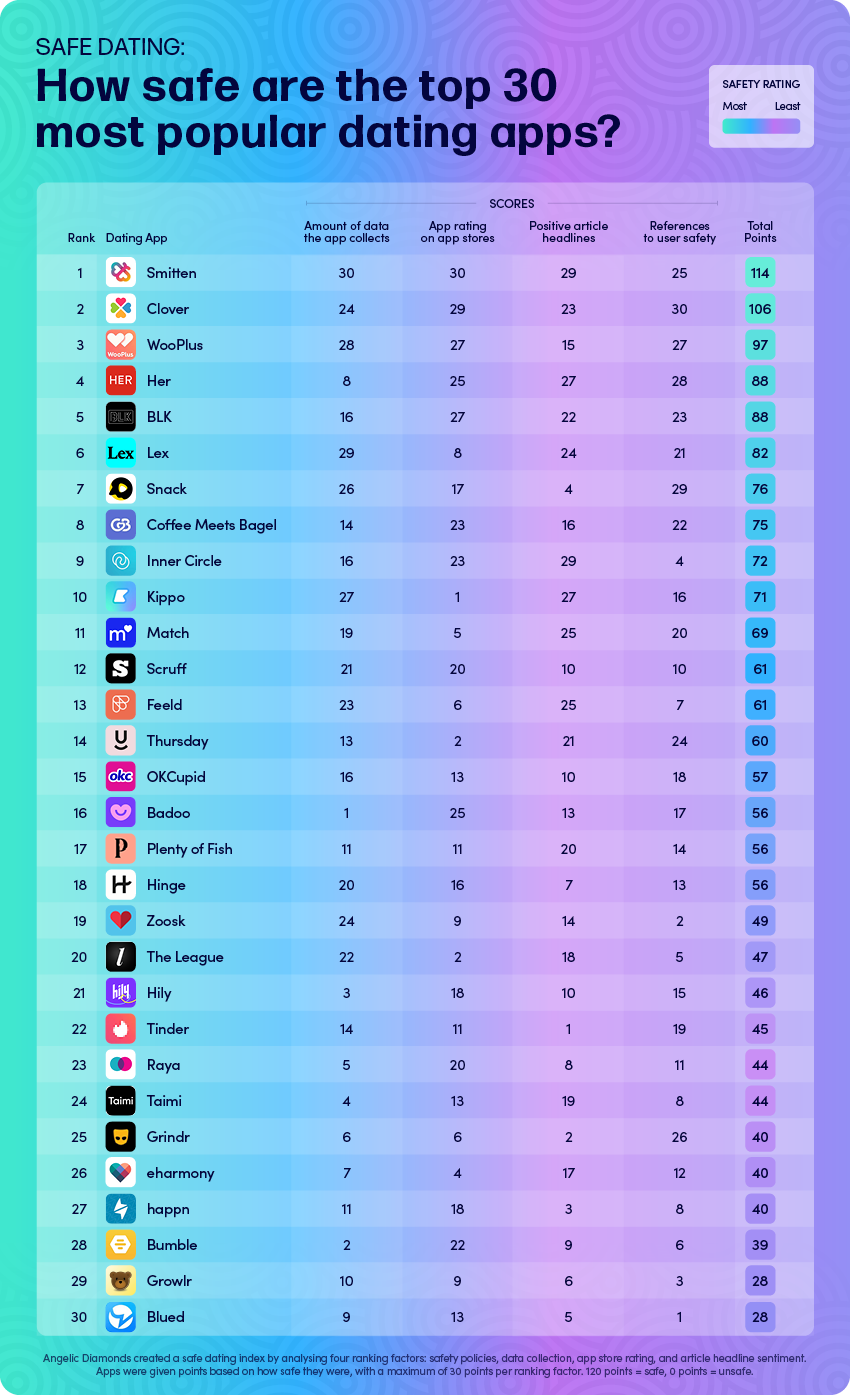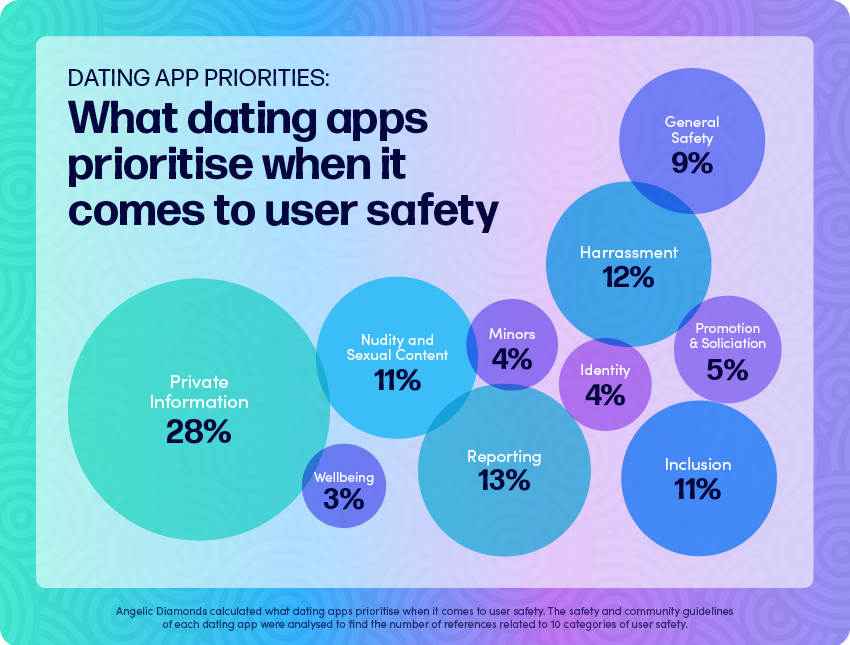Safe Dating: Swipe Smart, Love Safe

With an estimated 366 million users in 2022, dating apps are a popular way to meet new people and find true love, but they can also be risky. In the UK, police cases linked to dating apps have risen by 175%, while almost half (49%) of Americans have reported feeling unsafe on dating apps, highlighting the dangers that users need to be aware of.
To help people stay safe while looking for love, we have investigated 30 dating apps to find out which ones are the safest for daters. We have also explored dating trends for 2023 and sought expert advice from Amber Brooks, Editor-in-Chief at DatingAdvice.com to give you the best chance of finding love.
Key findings:
- Smitten is the safest dating app on the market, Blued is the least safe
- The two least safe dating apps are LGBTQ+ apps
- Smitten collects the least data from users, Badoo collects the most
- Tinder is the worst app for negative news articles, Inner Circle and Smitten are the best
- Clover has the most comprehensive community guidelines when it comes to user safety, Blued has the worst
- Protecting users’ private information is the biggest priority for dating apps, user wellbeing is the smallest
- Infla-dating, monogamish and green dating are going to be the biggest dating trends in 2023
How safe are the top 30 most popular dating apps?

We ranked 30 popular dating apps based on negative article headlines, references to user safety in community guidelines, data collection practices, and global app store ratings, with each app receiving a score out of 30 for each factor. A total out of 120 was then calculated with the highest scoring app being deemed the safest.
These factors highlight potential problems that users may encounter when using dating apps, and while they don't guarantee safety, they do serve as a good indicator.
Smitten is the safest dating app on the market

Impact Photography
Our research ranked the top five safest dating apps on the market, with Smitten being deemed the safest overall thanks to its high scores across the board. The app scored the highest out of all the apps when it comes to app store ratings (30) and respecting user privacy (30), collecting only nine types of data across five categories. Even the location data it collects is ‘coarse’, meaning it is an approximate location rather than exact.
Clover is the second safest dating app thanks to its impressive community guidelines score (30) including almost 80 references to all of the categories we searched for: inclusion, identity, harassment, nudity and sexual content, minors, private information, promotion and solicitation, reporting, wellbeing and general user safety.
WooPlus came in third with an overall score of 97, known for being one of the least invasive dating apps with minimal data collection, collecting only 10 types of data across seven categories.
HER, a popular lesbian dating app, is in fourth place with high scores for its positive article headlines (27), global app store ratings (25), and commitment to user safety within community guidelines (28).
BLK, a dating app for the Black community, completes the top five with above-average scores in most categories, its app store ratings being its highest scoring factor (27).
Bumble and eharmony are among the least safe dating apps
It may come as a surprise that well-known dating apps such as Tinder and Bumble didn’t score highly in our research. While Bumble is often very vocal about user safety, the app falls short when it comes to user privacy (2) and community guidelines (6), putting users at risk of hackers and other online dangers. Improving these areas could significantly enhance the safety of the app for its users.
Although Tinder’s community guidelines are relatively robust, missing only two categories of user safety with a score of 19 out of 30, the app scored the lowest out of all apps for reports of negative experiences in the media (1). This cannot be ignored and tells us that there are some safety elements lacking.
eharmony is another long-standing dating app that is well-known amongst online daters, yet many of its users have left negative reviews, leaving the app with an overall score of 40 and indicating that users have a negative experience when using it.
Two LGBTQ+ dating apps are the least safe on the market
For the LGBTQ+ community, trying to find love online comes with risks, and according to our research, the two least safe apps are all LGBTQ+ apps: Blued and GROWLr, both scoring 28 points out of 120 overall.
While it is positive to see that only one of the two apps received the lowest possible points for an individual ranking factor, they both still received poor scores across the board, resulting in the lowest scores overall.
Blued, a gay dating app with over 54 million users globally, scored the lowest out of all 30 apps for their community guidelines, a common theme amongst the lowest scoring apps overall.
The lack of respect for user privacy and the vulnerability to exploitation on these apps makes LGBTQ+ individuals easy targets for hate crimes, and can leave them worried that the people they are connecting with are untrustworthy.
Fortunately, there are other LGBTQ+ specific dating apps in our findings that are a lot safer to use.
As mentioned before, HER is the fourth safest dating app on the market right now. Boasting high scores for references to user safety in their community guidelines (28) and positive article headlines (27), the evidence suggests that this is an app that prioritises user safety. It is, however, let down slightly by the amount of data it collects, scoring just 8 out of 30 in this area.
Other LGBTQ+ specific apps that score well include Lex, which ranks 6th for overall safety, and SCRUFF, which ranks 12th.
Amber Brooks, Editor-in-Chief at DatingAdvice.com comments:
“It is interesting that the LGBTQ+ apps wouldn't score higher on the scale because safety and privacy are such big focuses for that niche. Unfortunately, LGBTQ+ apps need to prioritise safety for a reason -- their members are often targeted for harassment and threats. Sometimes these niche spaces actually become a target for homophobic people who join with ill intentions.
“As much as online dating apps and sites try to police their memberships, it isn't always possible to flag a person who poses a threat until they do or say something threatening. That's a challenge that industry leaders are looking to solve with technology that proactively verifies user identities and monitors online behaviour. Community guidelines are one way that apps and sites set a tone for users. The feminist dating app Bumble has banned photos of guns or violence, and the lesbian dating app HER bans profiles created by couples or anyone who identifies as a man.”
Of course many apps are inclusive, something that we looked for when analysing community guidelines, so if you’re looking for love online you should make sure you know how to date safely and what to look out for, regardless of the app you use.
Safeguarding private information is the top priority for dating apps

We often see apps announcing updates to their safety features, or reassuring users that a recent news report is an anomaly, but do their own community and safety guidelines align with what they publicise?
As part of our research, we analysed community and safety guidelines of all 30 dating apps to find out how often inferences were made of the following categories of user safety: inclusion, identity, harassment, nudity and sexual content, minors, private information, promotion and solicitation, reporting, wellbeing and general user safety.
Protecting users’ private information was found to be the biggest priority with 28% of references focusing on safeguarding users' data. While it's understandable given the amount of personal information shared on these platforms, it's interesting to note that this priority ranks higher than inclusion (11%) and underage users (4%).
The second biggest priority for dating apps is reporting, evidenced by apps like Bumble making efforts to streamline the reporting process for users. This focus on reporting goes hand in hand with addressing harassment, which ranks as the third highest priority for the dating app industry.
Despite the impact dating apps can have on users' mental health, our research shows that their focus on user wellbeing is lacking. In fact, user wellbeing ranks as the lowest priority across the 30 dating apps we analysed (3%). While it's important for apps to prioritise protecting users' information and address harassment, more attention should be given to the impact these platforms have on users' mental and emotional health.
Dating expert shares her top safety advice for singletons'
When it comes to safety there are certain pieces of advice you should keep in mind, regardless of the dating app you choose to use.
Amber Brooks, Editor-in-Chief at DatingAdvice.com shares her advice:
“When it comes to staying safe online, most singles are aware of common red flags like a profile with no picture or a Nigerian prince asking for money. However, they may not realise that romance scammers have gotten more advanced than the Nigerian princes of old.
“Fake profiles these days often do post a photo because they know the response rate is highest for profiles with photos. A lot of the time, it'll be a person in a military uniform because that garners a lot of trust and respect -- and it offers a quick excuse for why the person cannot meet in person.
“Some scammers will chat with their online matches for weeks or months before asking to "borrow" money for travel expenses or some sort of emergency. Giving money to an online dating match is never a good idea, even a small ask to renew a dating membership can lead to more and more favours.
“Our advice to singles is to stay chatting on the app or site until you meet in person. That way, you can block and report bad actors who seem sketchy or dangerous. Video dates are becoming a more common vetting tool for singles, and that's great for safety because it allows singles to verify that the face matches the online photo before meeting in person. Just be aware that scammers may try to claim their webcam is broken or use a still image in the video chat to fool marks.”
Glossary: The top 10 dating trends to look out for in 2023
 Unsplash / Jonathan Leppan
Unsplash / Jonathan Leppan
Unsplash / Jonathan Leppan
The increasing popularity of dating apps has caused new dating trends to emerge, meaning dating safely goes beyond just choosing the safest app and following rules. That is why we have taken a deep dive into over 80 dating trends from the past decade to find out which ones you need to be aware of when searching for The One.
Using Google search data, we’ve identified the dating trends with the biggest increase in searches so far in 2023 across the US, UK and Canada.
We’ve enlisted the help of Amber Brooks, Editor-in-Chief at DatingAdvice.com to help us break down the trends and provide tips so that you can focus on finding your soulmate, wherever they may be.
The dating trends increasing in popularity in 2023
- Infla-dating (1015% increase in searches since the beginning of 2023)
This involves opting for less-expensive outings with a romantic partner during these uncertain economic times. - Monogamish (128% increase in searches since the beginning of 2023)
When a couple has an agreement that allows for one-off encounters in certain circumstances that have been previously agreed. - Green Dating (125% increase in searches since the beginning of 2023)
A trend for people who have an invested interest in “environmentalism” and are more interested in going on ‘green’ dates. - Eco Dating (100% increase in searches since the beginning of 2023)
Similar to green dating, eco dating means that you're dating with the express interest of creating as little waste as possible and working towards a greener, more sustainable world. It also includes eco dumping, whereby you'll end a relationship due to different views on the environment. - Darwinning (100% increase in searches since the beginning of 2023)
When people want to avoid dating someone who doesn’t believe in science, for example anti-vaxxers, flat-earthers or climate change deniers. - Cyberflashing (60% increase in searches since the beginning of 2023)
This involves offenders sending an unsolicited sexual image to people via social media or dating apps. - Untyping (55% increase in searches since the beginning of 2023)
This involves ditching the comfort zone and dating outside of your usual type. Famous examples include Kim Kardashian and Pete Davidson. - Dawn Dating (50% increase in searches since the beginning of 2023)
This is for people who prefer going on early morning dates, from coffees to runs instead of evening or late afternoon dates. This aligns with the dry/sober dating trend that is growing in popularity. - Mosting (50% increase in searches since the beginning of 2023)
When someone makes you feel super special, plays like they’re so into what the two of you have, and hype you up about the future, only to then ghost. It’s where love bombing and ghosting join forces. And it’s brutal. - Sober Dating (50% increase in searches since the beginning of 2023)
This is for those who choose not to drink alcohol on dates. Where alcohol can be a crutch that enables us to lower our inhibitions just enough to relax our nerves, some people believe that it shouldn't be necessary to have around when getting to know someone.
Amber Brooks, Editor-in-Chief at DatingAdvice.com comments:
“As far as the trends go, it's always so fascinating to see what new terms daters come up with to describe their experiences and frustrations.
“Infla-dating is certainly top of mind these days as prices for dining at a restaurant or even grabbing a cup of coffee with a new person increase. Over the last few years, we've seen singles embracing more affordable date options -- cooking at home, finding free shows, or visiting a museum. They are also more open to using technology to host video dates that don't require singles to even leave the house.
“Sober dating is also on the rise as it's an easy way to save cash and keep your wits about you on those early dates.
“The team at DatingAdvice.com is always tracking dating terms and trends, which constantly change as younger generations come of age and begin to make their mark on the dating scene.”
We understand the importance of finding love and building healthy relationships, however we also know how important it is for you to be safe while searching for The One online. That's why we encourage all daters to take a look at our research and consider the safety features of the dating apps they use.
Although our research found Clover to be the safest dating app on the market, it is important to note that no app is entirely risk free, which is why you must make sure to take steps to protect yourself and make sure you're aware of current dating trends.
Remember, finding love is a beautiful thing, but it should never come at the cost of your safety. We hope that our research and advice will help daters navigate the dating world safely and with confidence. So go ahead, find that special someone, and when the time comes to propose we’ll be here to help you select the perfect engagement ring.
If you’ve already met your soulmate by using dating apps and proposed, we’d love to hear about your story and help you find a wedding ring for your special day.
Methodology
We analysed articles online to compile a list of more than 50 dating apps to include in our study. From here, we condensed this down to 30 based on available data.
The index:
- The index was created based on a points system. Apps were ranked based on the sum of points from four ranking factors (negative headlines, app store rating, data collection, community guidelines). The maximum points available per ranking factor was 30, the maximum sum of points was 120. The higher the score, the safer the app.
- If two or more apps were tied for the same score, all affected apps were given the lowest points (e.g. both apps were given the 3 points rather than 4 points).
- If the total sum of the points were the same for more than one app, the app with the higher points for the safety guidelines was deemed safer.
Negative headlines:
- We used Google News and Buzzsumo to collect the top 10 articles from January 2022 to January 2023 per app, making sure to reference 'dating'/'app' if the brand name has multiple meanings.
- We then used GPT-3 to rate the article headlines based on sentiment (prompt: ‘Analyse the sentiment of the following article headlines, ranking them 0 (least negative) to -5 (most negative) and present the results in a table’). -5 being the most negative and 0 being neutral. We also cross-referenced the scores with SentiStrength to ensure the language model was correct.
- Each app was then given an average score (0 – -5) which was used to rank them.
- In the case of a tie, we calculated how many of the 10 article headlines received a score of -3 – -5, deemed those who received more negative articles overall as more dangerous.
Community guidelines:
- The safety terms and community guidelines were collected from the website of each app.
- The text was then analysed to find out how many times buzzwords were mentioned. These buzzwords were based on areas of user safety commonly highlighted by dating apps and articles discussing dating apps. The categories were:
- Inclusion (Inclusion, discrimination, LGBT, gender, ethnicity, orientation, respect)
- Identity (Catfish, verify, pretend, fraud, impersonation, legit, scam, identity)
- Harassment (Harassment, harass, inappropriate, hate, violence)
- Nudity and Sexual Content (Nudity and Sexual Content, sexual, Nude, nudes, nudity)
- Minors (Minor, minors, underage, under 18, 18 years, over 18)
- Private information (Private information, finances, address, information, money)
- Promotion and Solicitation (Promotion and Solicitation, prostitution, advert, solicitation, promotion, soliciting)
- Reporting (Reporting, report, investigate, unmatch, block)
- Wellbeing (Wellbeing, suicide, self-harm)
- Safety (Safe, safety)
- The frequency of these words were then used to calculate which safety elements dating apps prioritise the most.
- When ranking from 1-30, if there was a tie the app with references across more categories was deemed safer.
Data collection:
- Data was scraped from the Apple App Store for each app, based on the types of data collection Apple requires developers to disclose. The number of categories and individual types of data were used to calculate which apps collect the most data from you.
- The more data collected means the app is more dangerous.
- If there was a tie when ranking from 1-30, the app collecting data across the most categories was deemed more dangerous.
App store rankings:
- SimilarWeb was used to collect Google Play Store and Apple App Store rankings per app.
- An average was then calculated from both ratings. If there was no rating available for one of the app stores, the other available rating was used.
- Apps that didn't have a rating on either store were removed from the research.
Dating trends:
- We analysed articles from the past 10 years to compile a list of 82 dating trends.
- We then used Google Keyword Planner to collect the search volumes for each trend across the UK, US and Canada.
- Dating trends with the highest increase in searches over the past 3 months were deemed to be the trending terms of 2023.
All data was collected between 1st-10th February 2023.
You May Also Like

How to Choose the Right Diamond Carat
Choosing the right carat for a diamond ring is one of the most difficu ...

Everything You Ever Wanted to Know About Coloured ...
Picture a diamond and a sparkling colourless gemstone probably springs ...

5 Tips for the ultimate winter hen party
Winter isn’t one of the most popular times to have a hen party, ...
